Independent Adventuring - March 2006
March was a month of few games and even fewer news. Even though many of the titles were great, also thanks to a great set of challenges in the monthly AGS competition, there were a few games that left lots to be desired. Still, with several titles featuring lengthy gameplay, and a brand new adventure creation engine, one could have plenty of fun.
Niche news
Probably the biggest and yet most overlooked news of the month was the release of DizzyAGE, a game creation engine that allows its users to create games based on the popular Dizzy series, which ruled the ZX Spectrum world. The engine features a very impressive help file, and it’s apparent that it’s been thoroughly tested and polished prior to its release. By the end of the month, there have been three Dizzy games released. In addition to DizzyAGE, SCI Studio VGA was released, which allows users to create games resembling those from Sierra On-Line’s SCI era.
The commercial release of the month was Scratches, which immediately generated a slew of reviews. The game was covered by Gamespot, IGN, PC Gameworld, Gamezone, Gamefreaks365, The Quandary, Digital Entertainment News, Game Chronicles, Adventure Gamers, Game Over, Amped News, Gameboomers, Game Plasma, Bovine Conspiracy and Plain Games. Scores ranged from 39% to 100%, with the majority in the upper seventies and lower eighties. The Quandary also reviewed Tears of Betrayal, and the March issue of Adventure Lantern covers Hope Springs Eternal, Clink, Last Half of Darkness and Delaware St. John 1. Independent Gaming posted short reviews of Alfa Dream, Spooks and Stan Ames 1. The next commercial release of a independent adventure will be Barrow Hill, which has gone gold by the end of the month, and would sell for $25.99.
Adventures
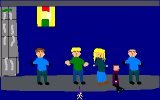 2010: World of Chaos. There are bad games, and then there are games that are so awful that you don’t know whether they are meant as a joke or not. Despite he author’s insistence that he was serious when creating this title, I’m still inclined to think that 2010 was meant as a parody of an over-the-top, very bad game. The graphics are terrible enough to have their own distinct character, and the story, which has you play a private investigator as he tries to chase a terrorist, seems to have been written by a seven year old. The game’s only redeeming feature is the very good original music. Still, you should try this title, if only to see how an excessively bad game looks like.
2010: World of Chaos. There are bad games, and then there are games that are so awful that you don’t know whether they are meant as a joke or not. Despite he author’s insistence that he was serious when creating this title, I’m still inclined to think that 2010 was meant as a parody of an over-the-top, very bad game. The graphics are terrible enough to have their own distinct character, and the story, which has you play a private investigator as he tries to chase a terrorist, seems to have been written by a seven year old. The game’s only redeeming feature is the very good original music. Still, you should try this title, if only to see how an excessively bad game looks like.
 Aescplega. This is quite a unique game, which takes place in Anglo-Saxon (pre-Norman) England. You play a villager who got his weapons stolen, and now he has to acquire new ones and find the thief. The story is very linear, with new quests being unlocked only after the previous ones are solved, but this does not detract from the game’s quality, which is tied to its unique setting. Puzzles, on the other hand, can often be on the frustrating side. They require some guesswork, especially when it comes to finding objects, and even though you’ll have the benefit of a linear gameplay you may end up being stuck in places. In addition to nice graphics and a very appropriate soundtrack, the game uses old English words from time to time, and those who want can translate them using the included glossary of terms. It is clear that the author is quite passionate about the topic, as he also included several riddles in Old English, with their translations and solutions. The game abruptly ends before the main story line is complete, but the author promises a sequel. I can’t wait.
Aescplega. This is quite a unique game, which takes place in Anglo-Saxon (pre-Norman) England. You play a villager who got his weapons stolen, and now he has to acquire new ones and find the thief. The story is very linear, with new quests being unlocked only after the previous ones are solved, but this does not detract from the game’s quality, which is tied to its unique setting. Puzzles, on the other hand, can often be on the frustrating side. They require some guesswork, especially when it comes to finding objects, and even though you’ll have the benefit of a linear gameplay you may end up being stuck in places. In addition to nice graphics and a very appropriate soundtrack, the game uses old English words from time to time, and those who want can translate them using the included glossary of terms. It is clear that the author is quite passionate about the topic, as he also included several riddles in Old English, with their translations and solutions. The game abruptly ends before the main story line is complete, but the author promises a sequel. I can’t wait.
 Alfa Dream. You fell asleep and woke up in your dream. Even though the beginning may have been a little overused, the rest of the game isn’t. The dream you wake up in is quite weird, but also strangely logical. Each room has its own architecture, and each character you meet has a purpose, and together they create a seamless world. Part of this harmony between locations can be attributed to a very nice graphical element: a sort of animated noise, which overlays the screen. On the downside, this causes the game download to be enormous, considering its short gameplay. The production value unfortunately suffers from an absolute lack of sound (the author admitted that he tried to include it but was unable to come up with anything good enough) and language problems. In the latter case, the problem is not as much grammar as the failed attempt to translate a little philosophy into English. Puzzle-wise, the game is relatively easy, even though it does contain some dead ends. In this respect, the only thing I was truly frustrated with was the lack of clearly marked room exits. The backgrounds are so well drawn that often you won’t know where you can go. Overall, this is a very interesting first attempt at an adventure game, which will initially cause admiration for the graphics. Once the novelty wears off, however, the lack of sounds and the inability of the author to communicate his ideas a little more clearly may be in the way. Still, if you don’t mind the large, 40MB download, you should by all means try this game.
Alfa Dream. You fell asleep and woke up in your dream. Even though the beginning may have been a little overused, the rest of the game isn’t. The dream you wake up in is quite weird, but also strangely logical. Each room has its own architecture, and each character you meet has a purpose, and together they create a seamless world. Part of this harmony between locations can be attributed to a very nice graphical element: a sort of animated noise, which overlays the screen. On the downside, this causes the game download to be enormous, considering its short gameplay. The production value unfortunately suffers from an absolute lack of sound (the author admitted that he tried to include it but was unable to come up with anything good enough) and language problems. In the latter case, the problem is not as much grammar as the failed attempt to translate a little philosophy into English. Puzzle-wise, the game is relatively easy, even though it does contain some dead ends. In this respect, the only thing I was truly frustrated with was the lack of clearly marked room exits. The backgrounds are so well drawn that often you won’t know where you can go. Overall, this is a very interesting first attempt at an adventure game, which will initially cause admiration for the graphics. Once the novelty wears off, however, the lack of sounds and the inability of the author to communicate his ideas a little more clearly may be in the way. Still, if you don’t mind the large, 40MB download, you should by all means try this game.
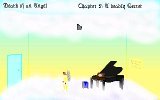 Death of an Angel. The author, a veteran of MAGS game competitions, has gained certain reputation at creating games with original stories, characters and interface, and this title is no exception. You play an angel who needs to find out why another angel died. The story itself is quite clichéd this time; the moment I entered the last chapter I knew what would happen. However, the interface is once again very unique and appropriate to the game, and the writing is not all that usual for adventure games. The title is heavily scripted, and some of the puzzles are rather obscure, but with the exception of one, which requires more musical knowledge that I have, they are doable. The graphics suffer from a font I found nearly impossible to read, and the music can get quite annoying. It features a song on a loop, which makes it very easy to pick up when it ends and starts playing again. The first two dozen of times I could bear listening to the song, but then I just had to turn off the sound to keep my sanity. Still, it is a very well done game, especially considering it’s been created in a few weeks.
Death of an Angel. The author, a veteran of MAGS game competitions, has gained certain reputation at creating games with original stories, characters and interface, and this title is no exception. You play an angel who needs to find out why another angel died. The story itself is quite clichéd this time; the moment I entered the last chapter I knew what would happen. However, the interface is once again very unique and appropriate to the game, and the writing is not all that usual for adventure games. The title is heavily scripted, and some of the puzzles are rather obscure, but with the exception of one, which requires more musical knowledge that I have, they are doable. The graphics suffer from a font I found nearly impossible to read, and the music can get quite annoying. It features a song on a loop, which makes it very easy to pick up when it ends and starts playing again. The first two dozen of times I could bear listening to the song, but then I just had to turn off the sound to keep my sanity. Still, it is a very well done game, especially considering it’s been created in a few weeks.
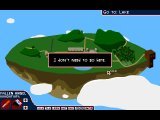 Fallen Angel. An angel falls on a piece of floating rock you call your home. Apparently, it’s paralyzed, and you need to find a way to save it, with only very little information to work on. To make matters worse, your game world was probably designed for a much larger game, as most locations will not let you enter, and those that will are almost invisible on the map, courtesy of very small hotspots. Once you find those two locations you’ll run into the next issue, heavy and sometimes unnecessary scripting. As a result, new options will appear only after you finish a certain task, and you’ll easily get frustrated because you won’t realize that whatever didn’t work previously may work later. To make matters more confusing, the game opens many questions, such as how comes you are so familiar with a robot who you weren’t supposed to have met previously, why there is a dead body with a radio, and much more. Overall, I was left with mixed feelings about this title. On one hand, the scripting and pixel hunting present a relatively frustrating gameplay; on the other, the production value shows great effort.
Fallen Angel. An angel falls on a piece of floating rock you call your home. Apparently, it’s paralyzed, and you need to find a way to save it, with only very little information to work on. To make matters worse, your game world was probably designed for a much larger game, as most locations will not let you enter, and those that will are almost invisible on the map, courtesy of very small hotspots. Once you find those two locations you’ll run into the next issue, heavy and sometimes unnecessary scripting. As a result, new options will appear only after you finish a certain task, and you’ll easily get frustrated because you won’t realize that whatever didn’t work previously may work later. To make matters more confusing, the game opens many questions, such as how comes you are so familiar with a robot who you weren’t supposed to have met previously, why there is a dead body with a radio, and much more. Overall, I was left with mixed feelings about this title. On one hand, the scripting and pixel hunting present a relatively frustrating gameplay; on the other, the production value shows great effort.
 The Game That Takes Place on a Cruise Ship. Just as the title implies, there won’t be any doubt that you’re playing an adventure game. Throughout the gameplay, you’ll be reminded of it over and over again, as you steal things, stuff impossibly large items into your inventory, and do other adventure-related nonsense. Not that it hurts this game in any way; in fact, it adds a great deal of personality. TGTPOACS (sorry; I won’t spell the name out again) is a superb title, which offers very good graphics and music, but more importantly, a host of very original characters and four different paths to take. This last thing alone will let you play this title for longer than some commercial adventures I’ve seen. Unfortunately, due to this, there are a lot of useless items you’ll collect. Because of this, the first part of the game, common to all four paths, plays more like an adventure game simulator where you wander around, talk to people and collect everything you can. It does not have a storyline, and you may feel a little lost. Here, the jabs at conventional adventure gaming are very welcome: they lighten up the mood, and ease the frustration of some of the less obvious puzzles, such as asking a character the same question eleven times to get further. Once the fork in the story occurs and you select one of four available paths, the game picks up and offers a very professionally designed series of puzzles, leading to one of the four ultimate conclusions. If you play one game released in March, make it this one.
The Game That Takes Place on a Cruise Ship. Just as the title implies, there won’t be any doubt that you’re playing an adventure game. Throughout the gameplay, you’ll be reminded of it over and over again, as you steal things, stuff impossibly large items into your inventory, and do other adventure-related nonsense. Not that it hurts this game in any way; in fact, it adds a great deal of personality. TGTPOACS (sorry; I won’t spell the name out again) is a superb title, which offers very good graphics and music, but more importantly, a host of very original characters and four different paths to take. This last thing alone will let you play this title for longer than some commercial adventures I’ve seen. Unfortunately, due to this, there are a lot of useless items you’ll collect. Because of this, the first part of the game, common to all four paths, plays more like an adventure game simulator where you wander around, talk to people and collect everything you can. It does not have a storyline, and you may feel a little lost. Here, the jabs at conventional adventure gaming are very welcome: they lighten up the mood, and ease the frustration of some of the less obvious puzzles, such as asking a character the same question eleven times to get further. Once the fork in the story occurs and you select one of four available paths, the game picks up and offers a very professionally designed series of puzzles, leading to one of the four ultimate conclusions. If you play one game released in March, make it this one.
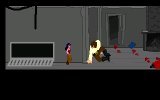 Piratess. You play a female pirate on a quest to do something. The game is very disjointed, not only divided into three parts that never really come together, but even has end titles before the last part of the gameplay. The puzzles can be quite obscure, and you’ll suffer some frustration from non-skippable text. Presentation-wise, the game is limited to a few simple tunes and sounds, and the graphics are all over the place, with black-and white screens, relatively good room graphics, oversized characters and more. All in all, it looks like an experiment by the author to learn scripting, with features like a timed task and dialogue trees, and not as a full game. At the end, the author admitted that he released the title unfinished, and that he wouldn’t care whether the game was playable. Neither should you care about downloading it; there are many better ones available.
Piratess. You play a female pirate on a quest to do something. The game is very disjointed, not only divided into three parts that never really come together, but even has end titles before the last part of the gameplay. The puzzles can be quite obscure, and you’ll suffer some frustration from non-skippable text. Presentation-wise, the game is limited to a few simple tunes and sounds, and the graphics are all over the place, with black-and white screens, relatively good room graphics, oversized characters and more. All in all, it looks like an experiment by the author to learn scripting, with features like a timed task and dialogue trees, and not as a full game. At the end, the author admitted that he released the title unfinished, and that he wouldn’t care whether the game was playable. Neither should you care about downloading it; there are many better ones available.
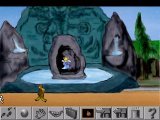 Sky Adventure. You have crashed on a floating island full of angels, and you need to repair your ship. The island offers plenty of challenges, though, such as the lack of stairs (after all, angel can fly), and a grumpy old tree that doesn’t let you gather any wood needed for the repairs. This game features background graphics, which I liked very much. Unfortunately, the title also contains some of the worst language (grammar-wise) I’ve ever encountered, and some of the puzzles are not intuitive. It is a worthy MAGS submission, but not all that great.
Sky Adventure. You have crashed on a floating island full of angels, and you need to repair your ship. The island offers plenty of challenges, though, such as the lack of stairs (after all, angel can fly), and a grumpy old tree that doesn’t let you gather any wood needed for the repairs. This game features background graphics, which I liked very much. Unfortunately, the title also contains some of the worst language (grammar-wise) I’ve ever encountered, and some of the puzzles are not intuitive. It is a worthy MAGS submission, but not all that great.
 Sven Gordan Paranormal Parody. If imitation is the ultimate form of flattery, parody is not far behind. The maker of the Ben Jordan series must be very happy to learn that a second game making fun of his work was released, and this time the result was much better than the first title, Ben Jordan: Paranormal Warrior Within. This game starts out similarly as the original, but at several spots it makes certain deviations to develop a few jokes. I personally found the production value even better than the real Ben Jordan 1, with very cute graphics and an appropriate soundtrack. Unfortunately, the title also was a little shorter and much easier, but it should still entertain you for ten minutes or so.
Sven Gordan Paranormal Parody. If imitation is the ultimate form of flattery, parody is not far behind. The maker of the Ben Jordan series must be very happy to learn that a second game making fun of his work was released, and this time the result was much better than the first title, Ben Jordan: Paranormal Warrior Within. This game starts out similarly as the original, but at several spots it makes certain deviations to develop a few jokes. I personally found the production value even better than the real Ben Jordan 1, with very cute graphics and an appropriate soundtrack. Unfortunately, the title also was a little shorter and much easier, but it should still entertain you for ten minutes or so.
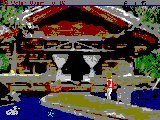 Water Quest. You came home, and you are very thirsty. And now you are looking for some water. This seemingly simple premise sends you through a series of photo backgrounds, very poorly marked transition zones between screens and illustrations that are not up to par, in order to find a way to get your water running again. The game is the first attempt of a new author, and in its current stage it is not very appealing. Due to the backgrounds, the download file is relatively large, but the graphics are poor in their pixilated form. The story is quite confusing, and some of its twists are illogical. The good news is that the author has been paying close attention to feedback and has been improving the game, and this leads me to believe that his next effort will be much better.
Water Quest. You came home, and you are very thirsty. And now you are looking for some water. This seemingly simple premise sends you through a series of photo backgrounds, very poorly marked transition zones between screens and illustrations that are not up to par, in order to find a way to get your water running again. The game is the first attempt of a new author, and in its current stage it is not very appealing. Due to the backgrounds, the download file is relatively large, but the graphics are poor in their pixilated form. The story is quite confusing, and some of its twists are illogical. The good news is that the author has been paying close attention to feedback and has been improving the game, and this leads me to believe that his next effort will be much better.
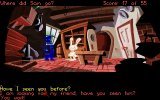 Where did Sam Go? This is a very short game based on Sam & Max, with mixed-in characters from the Monkey Island series. You play as Sam, with the goal to find Max who got lost in a wacky-looking house. The author admits that the game is incomplete, and as such you should have absolutely no problems finishing it: it only takes two items to do so; the rest of the things you find (even those you can’t pick up) seem to serve no purpose. The graphics and music are appropriately crazy (in a “happy” sense), but the current game length and difficulty level leave a lot to be desired.
Where did Sam Go? This is a very short game based on Sam & Max, with mixed-in characters from the Monkey Island series. You play as Sam, with the goal to find Max who got lost in a wacky-looking house. The author admits that the game is incomplete, and as such you should have absolutely no problems finishing it: it only takes two items to do so; the rest of the things you find (even those you can’t pick up) seem to serve no purpose. The graphics and music are appropriately crazy (in a “happy” sense), but the current game length and difficulty level leave a lot to be desired.
Interactive fiction
Showtime at the Gallows. Texas Chainsaw Massacre never read so good. You play a washout everybody used to make fun of because he was always scared of everything. But when faced with a real maniac who just took apart our friend limb by limb, you must pull yourself together in order to survive. This is an extremely well written adventure, which suffers from only one problem: the majority of the time you will be waiting. This is not a big deal, though, as you’ll keep being entertained by the text, as it scrolls by. With the exception of a few over the top clichés (abusive father whom your mother later killed), the story is very gripping, and won’t let you go until you die. Or maybe make it out alive, after several attempts.
Other games
With the release of DizzyAGE, a whole new world of arcade adventures has opened up. Until now, I only covered non-adventure games created with AGS in this section, but from now I’ll include arcade adventures as well.
 Dizzy and the Emerald Eye. This is the first Dizzy game created by other than the author of DizzyAGE. It is longer than the other two games released last month, but not as polished. This time, Dizzy has agreed to help a troll find a certain gem, and to do this he must go on a series of FedEx quests, jump till your fingers hurt and take care of his cash problem. The game plays relatively easily, with some tasks being obvious even before you are made aware of them. The biggest downside I’ve encountered is a very frustrating sequence of jumping on clouds across several screens, which can get quite repetitive as you hit the wrong jump button or let your character fall through a cloud over and over again. Still, it should kill your boredom for an hour or two.
Dizzy and the Emerald Eye. This is the first Dizzy game created by other than the author of DizzyAGE. It is longer than the other two games released last month, but not as polished. This time, Dizzy has agreed to help a troll find a certain gem, and to do this he must go on a series of FedEx quests, jump till your fingers hurt and take care of his cash problem. The game plays relatively easily, with some tasks being obvious even before you are made aware of them. The biggest downside I’ve encountered is a very frustrating sequence of jumping on clouds across several screens, which can get quite repetitive as you hit the wrong jump button or let your character fall through a cloud over and over again. Still, it should kill your boredom for an hour or two.
 Dizzy and the Healing Potion. Daisy is sick, and you need to collect ingredients for a healing potion. Even though there are only three, you’ll face several obstacles in collecting them, in particular non-obvious exits from some of the screens. Still, this is the perfect introduction to the world of Dizzy, as it offers very believable characters and no possibility of injury or death. I’ve had a blast playing this little title.
Dizzy and the Healing Potion. Daisy is sick, and you need to collect ingredients for a healing potion. Even though there are only three, you’ll face several obstacles in collecting them, in particular non-obvious exits from some of the screens. Still, this is the perfect introduction to the world of Dizzy, as it offers very believable characters and no possibility of injury or death. I’ve had a blast playing this little title.
 Dizzy and the Mushroom Pie. Dizzy is locked in a cave, as he tries to collect some mushrooms for a pie. This game is a rather rude awakening for those who played the previous game first, as they may get killed almost instantly. Fortunately, the game is not all that difficult, and it introduces some advanced elements, such as coin collecting and avoiding monsters. The story suffers a little from a lack of introduction, and unless you read the short introduction on the Web site you won’t necessarily know what you are supposed to do.
Dizzy and the Mushroom Pie. Dizzy is locked in a cave, as he tries to collect some mushrooms for a pie. This game is a rather rude awakening for those who played the previous game first, as they may get killed almost instantly. Fortunately, the game is not all that difficult, and it introduces some advanced elements, such as coin collecting and avoiding monsters. The story suffers a little from a lack of introduction, and unless you read the short introduction on the Web site you won’t necessarily know what you are supposed to do.
March has featured some great games. In particular, The Game That Takes Place on a Cruise Ship and Alfa Dream offered some eye candy in addition to good gameplay, and Death of an Angel and Aescplega were very original, each in its own way. Even the few weak titles, such as Piratess and Water Quest didn’t spoil my mood, especially after I was made aware of DizzyAGE and the games created with this new engine. Let’s just hope that in the following months we’ll see more Dizzy games being added to the always great lineup of independent adventures.
Niche news
Probably the biggest and yet most overlooked news of the month was the release of DizzyAGE, a game creation engine that allows its users to create games based on the popular Dizzy series, which ruled the ZX Spectrum world. The engine features a very impressive help file, and it’s apparent that it’s been thoroughly tested and polished prior to its release. By the end of the month, there have been three Dizzy games released. In addition to DizzyAGE, SCI Studio VGA was released, which allows users to create games resembling those from Sierra On-Line’s SCI era.
The commercial release of the month was Scratches, which immediately generated a slew of reviews. The game was covered by Gamespot, IGN, PC Gameworld, Gamezone, Gamefreaks365, The Quandary, Digital Entertainment News, Game Chronicles, Adventure Gamers, Game Over, Amped News, Gameboomers, Game Plasma, Bovine Conspiracy and Plain Games. Scores ranged from 39% to 100%, with the majority in the upper seventies and lower eighties. The Quandary also reviewed Tears of Betrayal, and the March issue of Adventure Lantern covers Hope Springs Eternal, Clink, Last Half of Darkness and Delaware St. John 1. Independent Gaming posted short reviews of Alfa Dream, Spooks and Stan Ames 1. The next commercial release of a independent adventure will be Barrow Hill, which has gone gold by the end of the month, and would sell for $25.99.
Adventures
 2010: World of Chaos. There are bad games, and then there are games that are so awful that you don’t know whether they are meant as a joke or not. Despite he author’s insistence that he was serious when creating this title, I’m still inclined to think that 2010 was meant as a parody of an over-the-top, very bad game. The graphics are terrible enough to have their own distinct character, and the story, which has you play a private investigator as he tries to chase a terrorist, seems to have been written by a seven year old. The game’s only redeeming feature is the very good original music. Still, you should try this title, if only to see how an excessively bad game looks like.
2010: World of Chaos. There are bad games, and then there are games that are so awful that you don’t know whether they are meant as a joke or not. Despite he author’s insistence that he was serious when creating this title, I’m still inclined to think that 2010 was meant as a parody of an over-the-top, very bad game. The graphics are terrible enough to have their own distinct character, and the story, which has you play a private investigator as he tries to chase a terrorist, seems to have been written by a seven year old. The game’s only redeeming feature is the very good original music. Still, you should try this title, if only to see how an excessively bad game looks like. Aescplega. This is quite a unique game, which takes place in Anglo-Saxon (pre-Norman) England. You play a villager who got his weapons stolen, and now he has to acquire new ones and find the thief. The story is very linear, with new quests being unlocked only after the previous ones are solved, but this does not detract from the game’s quality, which is tied to its unique setting. Puzzles, on the other hand, can often be on the frustrating side. They require some guesswork, especially when it comes to finding objects, and even though you’ll have the benefit of a linear gameplay you may end up being stuck in places. In addition to nice graphics and a very appropriate soundtrack, the game uses old English words from time to time, and those who want can translate them using the included glossary of terms. It is clear that the author is quite passionate about the topic, as he also included several riddles in Old English, with their translations and solutions. The game abruptly ends before the main story line is complete, but the author promises a sequel. I can’t wait.
Aescplega. This is quite a unique game, which takes place in Anglo-Saxon (pre-Norman) England. You play a villager who got his weapons stolen, and now he has to acquire new ones and find the thief. The story is very linear, with new quests being unlocked only after the previous ones are solved, but this does not detract from the game’s quality, which is tied to its unique setting. Puzzles, on the other hand, can often be on the frustrating side. They require some guesswork, especially when it comes to finding objects, and even though you’ll have the benefit of a linear gameplay you may end up being stuck in places. In addition to nice graphics and a very appropriate soundtrack, the game uses old English words from time to time, and those who want can translate them using the included glossary of terms. It is clear that the author is quite passionate about the topic, as he also included several riddles in Old English, with their translations and solutions. The game abruptly ends before the main story line is complete, but the author promises a sequel. I can’t wait. Alfa Dream. You fell asleep and woke up in your dream. Even though the beginning may have been a little overused, the rest of the game isn’t. The dream you wake up in is quite weird, but also strangely logical. Each room has its own architecture, and each character you meet has a purpose, and together they create a seamless world. Part of this harmony between locations can be attributed to a very nice graphical element: a sort of animated noise, which overlays the screen. On the downside, this causes the game download to be enormous, considering its short gameplay. The production value unfortunately suffers from an absolute lack of sound (the author admitted that he tried to include it but was unable to come up with anything good enough) and language problems. In the latter case, the problem is not as much grammar as the failed attempt to translate a little philosophy into English. Puzzle-wise, the game is relatively easy, even though it does contain some dead ends. In this respect, the only thing I was truly frustrated with was the lack of clearly marked room exits. The backgrounds are so well drawn that often you won’t know where you can go. Overall, this is a very interesting first attempt at an adventure game, which will initially cause admiration for the graphics. Once the novelty wears off, however, the lack of sounds and the inability of the author to communicate his ideas a little more clearly may be in the way. Still, if you don’t mind the large, 40MB download, you should by all means try this game.
Alfa Dream. You fell asleep and woke up in your dream. Even though the beginning may have been a little overused, the rest of the game isn’t. The dream you wake up in is quite weird, but also strangely logical. Each room has its own architecture, and each character you meet has a purpose, and together they create a seamless world. Part of this harmony between locations can be attributed to a very nice graphical element: a sort of animated noise, which overlays the screen. On the downside, this causes the game download to be enormous, considering its short gameplay. The production value unfortunately suffers from an absolute lack of sound (the author admitted that he tried to include it but was unable to come up with anything good enough) and language problems. In the latter case, the problem is not as much grammar as the failed attempt to translate a little philosophy into English. Puzzle-wise, the game is relatively easy, even though it does contain some dead ends. In this respect, the only thing I was truly frustrated with was the lack of clearly marked room exits. The backgrounds are so well drawn that often you won’t know where you can go. Overall, this is a very interesting first attempt at an adventure game, which will initially cause admiration for the graphics. Once the novelty wears off, however, the lack of sounds and the inability of the author to communicate his ideas a little more clearly may be in the way. Still, if you don’t mind the large, 40MB download, you should by all means try this game. Death of an Angel. The author, a veteran of MAGS game competitions, has gained certain reputation at creating games with original stories, characters and interface, and this title is no exception. You play an angel who needs to find out why another angel died. The story itself is quite clichéd this time; the moment I entered the last chapter I knew what would happen. However, the interface is once again very unique and appropriate to the game, and the writing is not all that usual for adventure games. The title is heavily scripted, and some of the puzzles are rather obscure, but with the exception of one, which requires more musical knowledge that I have, they are doable. The graphics suffer from a font I found nearly impossible to read, and the music can get quite annoying. It features a song on a loop, which makes it very easy to pick up when it ends and starts playing again. The first two dozen of times I could bear listening to the song, but then I just had to turn off the sound to keep my sanity. Still, it is a very well done game, especially considering it’s been created in a few weeks.
Death of an Angel. The author, a veteran of MAGS game competitions, has gained certain reputation at creating games with original stories, characters and interface, and this title is no exception. You play an angel who needs to find out why another angel died. The story itself is quite clichéd this time; the moment I entered the last chapter I knew what would happen. However, the interface is once again very unique and appropriate to the game, and the writing is not all that usual for adventure games. The title is heavily scripted, and some of the puzzles are rather obscure, but with the exception of one, which requires more musical knowledge that I have, they are doable. The graphics suffer from a font I found nearly impossible to read, and the music can get quite annoying. It features a song on a loop, which makes it very easy to pick up when it ends and starts playing again. The first two dozen of times I could bear listening to the song, but then I just had to turn off the sound to keep my sanity. Still, it is a very well done game, especially considering it’s been created in a few weeks. Fallen Angel. An angel falls on a piece of floating rock you call your home. Apparently, it’s paralyzed, and you need to find a way to save it, with only very little information to work on. To make matters worse, your game world was probably designed for a much larger game, as most locations will not let you enter, and those that will are almost invisible on the map, courtesy of very small hotspots. Once you find those two locations you’ll run into the next issue, heavy and sometimes unnecessary scripting. As a result, new options will appear only after you finish a certain task, and you’ll easily get frustrated because you won’t realize that whatever didn’t work previously may work later. To make matters more confusing, the game opens many questions, such as how comes you are so familiar with a robot who you weren’t supposed to have met previously, why there is a dead body with a radio, and much more. Overall, I was left with mixed feelings about this title. On one hand, the scripting and pixel hunting present a relatively frustrating gameplay; on the other, the production value shows great effort.
Fallen Angel. An angel falls on a piece of floating rock you call your home. Apparently, it’s paralyzed, and you need to find a way to save it, with only very little information to work on. To make matters worse, your game world was probably designed for a much larger game, as most locations will not let you enter, and those that will are almost invisible on the map, courtesy of very small hotspots. Once you find those two locations you’ll run into the next issue, heavy and sometimes unnecessary scripting. As a result, new options will appear only after you finish a certain task, and you’ll easily get frustrated because you won’t realize that whatever didn’t work previously may work later. To make matters more confusing, the game opens many questions, such as how comes you are so familiar with a robot who you weren’t supposed to have met previously, why there is a dead body with a radio, and much more. Overall, I was left with mixed feelings about this title. On one hand, the scripting and pixel hunting present a relatively frustrating gameplay; on the other, the production value shows great effort.  The Game That Takes Place on a Cruise Ship. Just as the title implies, there won’t be any doubt that you’re playing an adventure game. Throughout the gameplay, you’ll be reminded of it over and over again, as you steal things, stuff impossibly large items into your inventory, and do other adventure-related nonsense. Not that it hurts this game in any way; in fact, it adds a great deal of personality. TGTPOACS (sorry; I won’t spell the name out again) is a superb title, which offers very good graphics and music, but more importantly, a host of very original characters and four different paths to take. This last thing alone will let you play this title for longer than some commercial adventures I’ve seen. Unfortunately, due to this, there are a lot of useless items you’ll collect. Because of this, the first part of the game, common to all four paths, plays more like an adventure game simulator where you wander around, talk to people and collect everything you can. It does not have a storyline, and you may feel a little lost. Here, the jabs at conventional adventure gaming are very welcome: they lighten up the mood, and ease the frustration of some of the less obvious puzzles, such as asking a character the same question eleven times to get further. Once the fork in the story occurs and you select one of four available paths, the game picks up and offers a very professionally designed series of puzzles, leading to one of the four ultimate conclusions. If you play one game released in March, make it this one.
The Game That Takes Place on a Cruise Ship. Just as the title implies, there won’t be any doubt that you’re playing an adventure game. Throughout the gameplay, you’ll be reminded of it over and over again, as you steal things, stuff impossibly large items into your inventory, and do other adventure-related nonsense. Not that it hurts this game in any way; in fact, it adds a great deal of personality. TGTPOACS (sorry; I won’t spell the name out again) is a superb title, which offers very good graphics and music, but more importantly, a host of very original characters and four different paths to take. This last thing alone will let you play this title for longer than some commercial adventures I’ve seen. Unfortunately, due to this, there are a lot of useless items you’ll collect. Because of this, the first part of the game, common to all four paths, plays more like an adventure game simulator where you wander around, talk to people and collect everything you can. It does not have a storyline, and you may feel a little lost. Here, the jabs at conventional adventure gaming are very welcome: they lighten up the mood, and ease the frustration of some of the less obvious puzzles, such as asking a character the same question eleven times to get further. Once the fork in the story occurs and you select one of four available paths, the game picks up and offers a very professionally designed series of puzzles, leading to one of the four ultimate conclusions. If you play one game released in March, make it this one. Piratess. You play a female pirate on a quest to do something. The game is very disjointed, not only divided into three parts that never really come together, but even has end titles before the last part of the gameplay. The puzzles can be quite obscure, and you’ll suffer some frustration from non-skippable text. Presentation-wise, the game is limited to a few simple tunes and sounds, and the graphics are all over the place, with black-and white screens, relatively good room graphics, oversized characters and more. All in all, it looks like an experiment by the author to learn scripting, with features like a timed task and dialogue trees, and not as a full game. At the end, the author admitted that he released the title unfinished, and that he wouldn’t care whether the game was playable. Neither should you care about downloading it; there are many better ones available.
Piratess. You play a female pirate on a quest to do something. The game is very disjointed, not only divided into three parts that never really come together, but even has end titles before the last part of the gameplay. The puzzles can be quite obscure, and you’ll suffer some frustration from non-skippable text. Presentation-wise, the game is limited to a few simple tunes and sounds, and the graphics are all over the place, with black-and white screens, relatively good room graphics, oversized characters and more. All in all, it looks like an experiment by the author to learn scripting, with features like a timed task and dialogue trees, and not as a full game. At the end, the author admitted that he released the title unfinished, and that he wouldn’t care whether the game was playable. Neither should you care about downloading it; there are many better ones available. Sky Adventure. You have crashed on a floating island full of angels, and you need to repair your ship. The island offers plenty of challenges, though, such as the lack of stairs (after all, angel can fly), and a grumpy old tree that doesn’t let you gather any wood needed for the repairs. This game features background graphics, which I liked very much. Unfortunately, the title also contains some of the worst language (grammar-wise) I’ve ever encountered, and some of the puzzles are not intuitive. It is a worthy MAGS submission, but not all that great.
Sky Adventure. You have crashed on a floating island full of angels, and you need to repair your ship. The island offers plenty of challenges, though, such as the lack of stairs (after all, angel can fly), and a grumpy old tree that doesn’t let you gather any wood needed for the repairs. This game features background graphics, which I liked very much. Unfortunately, the title also contains some of the worst language (grammar-wise) I’ve ever encountered, and some of the puzzles are not intuitive. It is a worthy MAGS submission, but not all that great. Sven Gordan Paranormal Parody. If imitation is the ultimate form of flattery, parody is not far behind. The maker of the Ben Jordan series must be very happy to learn that a second game making fun of his work was released, and this time the result was much better than the first title, Ben Jordan: Paranormal Warrior Within. This game starts out similarly as the original, but at several spots it makes certain deviations to develop a few jokes. I personally found the production value even better than the real Ben Jordan 1, with very cute graphics and an appropriate soundtrack. Unfortunately, the title also was a little shorter and much easier, but it should still entertain you for ten minutes or so.
Sven Gordan Paranormal Parody. If imitation is the ultimate form of flattery, parody is not far behind. The maker of the Ben Jordan series must be very happy to learn that a second game making fun of his work was released, and this time the result was much better than the first title, Ben Jordan: Paranormal Warrior Within. This game starts out similarly as the original, but at several spots it makes certain deviations to develop a few jokes. I personally found the production value even better than the real Ben Jordan 1, with very cute graphics and an appropriate soundtrack. Unfortunately, the title also was a little shorter and much easier, but it should still entertain you for ten minutes or so. Water Quest. You came home, and you are very thirsty. And now you are looking for some water. This seemingly simple premise sends you through a series of photo backgrounds, very poorly marked transition zones between screens and illustrations that are not up to par, in order to find a way to get your water running again. The game is the first attempt of a new author, and in its current stage it is not very appealing. Due to the backgrounds, the download file is relatively large, but the graphics are poor in their pixilated form. The story is quite confusing, and some of its twists are illogical. The good news is that the author has been paying close attention to feedback and has been improving the game, and this leads me to believe that his next effort will be much better.
Water Quest. You came home, and you are very thirsty. And now you are looking for some water. This seemingly simple premise sends you through a series of photo backgrounds, very poorly marked transition zones between screens and illustrations that are not up to par, in order to find a way to get your water running again. The game is the first attempt of a new author, and in its current stage it is not very appealing. Due to the backgrounds, the download file is relatively large, but the graphics are poor in their pixilated form. The story is quite confusing, and some of its twists are illogical. The good news is that the author has been paying close attention to feedback and has been improving the game, and this leads me to believe that his next effort will be much better. Where did Sam Go? This is a very short game based on Sam & Max, with mixed-in characters from the Monkey Island series. You play as Sam, with the goal to find Max who got lost in a wacky-looking house. The author admits that the game is incomplete, and as such you should have absolutely no problems finishing it: it only takes two items to do so; the rest of the things you find (even those you can’t pick up) seem to serve no purpose. The graphics and music are appropriately crazy (in a “happy” sense), but the current game length and difficulty level leave a lot to be desired.
Where did Sam Go? This is a very short game based on Sam & Max, with mixed-in characters from the Monkey Island series. You play as Sam, with the goal to find Max who got lost in a wacky-looking house. The author admits that the game is incomplete, and as such you should have absolutely no problems finishing it: it only takes two items to do so; the rest of the things you find (even those you can’t pick up) seem to serve no purpose. The graphics and music are appropriately crazy (in a “happy” sense), but the current game length and difficulty level leave a lot to be desired.Interactive fiction
Showtime at the Gallows. Texas Chainsaw Massacre never read so good. You play a washout everybody used to make fun of because he was always scared of everything. But when faced with a real maniac who just took apart our friend limb by limb, you must pull yourself together in order to survive. This is an extremely well written adventure, which suffers from only one problem: the majority of the time you will be waiting. This is not a big deal, though, as you’ll keep being entertained by the text, as it scrolls by. With the exception of a few over the top clichés (abusive father whom your mother later killed), the story is very gripping, and won’t let you go until you die. Or maybe make it out alive, after several attempts.
Other games
With the release of DizzyAGE, a whole new world of arcade adventures has opened up. Until now, I only covered non-adventure games created with AGS in this section, but from now I’ll include arcade adventures as well.
 Dizzy and the Emerald Eye. This is the first Dizzy game created by other than the author of DizzyAGE. It is longer than the other two games released last month, but not as polished. This time, Dizzy has agreed to help a troll find a certain gem, and to do this he must go on a series of FedEx quests, jump till your fingers hurt and take care of his cash problem. The game plays relatively easily, with some tasks being obvious even before you are made aware of them. The biggest downside I’ve encountered is a very frustrating sequence of jumping on clouds across several screens, which can get quite repetitive as you hit the wrong jump button or let your character fall through a cloud over and over again. Still, it should kill your boredom for an hour or two.
Dizzy and the Emerald Eye. This is the first Dizzy game created by other than the author of DizzyAGE. It is longer than the other two games released last month, but not as polished. This time, Dizzy has agreed to help a troll find a certain gem, and to do this he must go on a series of FedEx quests, jump till your fingers hurt and take care of his cash problem. The game plays relatively easily, with some tasks being obvious even before you are made aware of them. The biggest downside I’ve encountered is a very frustrating sequence of jumping on clouds across several screens, which can get quite repetitive as you hit the wrong jump button or let your character fall through a cloud over and over again. Still, it should kill your boredom for an hour or two. Dizzy and the Healing Potion. Daisy is sick, and you need to collect ingredients for a healing potion. Even though there are only three, you’ll face several obstacles in collecting them, in particular non-obvious exits from some of the screens. Still, this is the perfect introduction to the world of Dizzy, as it offers very believable characters and no possibility of injury or death. I’ve had a blast playing this little title.
Dizzy and the Healing Potion. Daisy is sick, and you need to collect ingredients for a healing potion. Even though there are only three, you’ll face several obstacles in collecting them, in particular non-obvious exits from some of the screens. Still, this is the perfect introduction to the world of Dizzy, as it offers very believable characters and no possibility of injury or death. I’ve had a blast playing this little title. Dizzy and the Mushroom Pie. Dizzy is locked in a cave, as he tries to collect some mushrooms for a pie. This game is a rather rude awakening for those who played the previous game first, as they may get killed almost instantly. Fortunately, the game is not all that difficult, and it introduces some advanced elements, such as coin collecting and avoiding monsters. The story suffers a little from a lack of introduction, and unless you read the short introduction on the Web site you won’t necessarily know what you are supposed to do.
Dizzy and the Mushroom Pie. Dizzy is locked in a cave, as he tries to collect some mushrooms for a pie. This game is a rather rude awakening for those who played the previous game first, as they may get killed almost instantly. Fortunately, the game is not all that difficult, and it introduces some advanced elements, such as coin collecting and avoiding monsters. The story suffers a little from a lack of introduction, and unless you read the short introduction on the Web site you won’t necessarily know what you are supposed to do. March has featured some great games. In particular, The Game That Takes Place on a Cruise Ship and Alfa Dream offered some eye candy in addition to good gameplay, and Death of an Angel and Aescplega were very original, each in its own way. Even the few weak titles, such as Piratess and Water Quest didn’t spoil my mood, especially after I was made aware of DizzyAGE and the games created with this new engine. Let’s just hope that in the following months we’ll see more Dizzy games being added to the always great lineup of independent adventures.

3 Comments:
Thanks for the nice review of TGTTPOACS. :)
Thanks for the update!!! I love the reviews.
Thanks for the encouragement :)
Post a Comment
<< Home